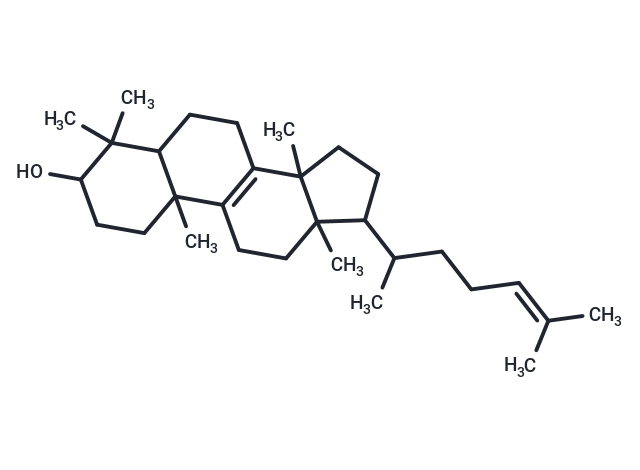Shopping Cart
- Remove All
 Your shopping cart is currently empty
Your shopping cart is currently empty

Euphol, an alcohol tetracyclic triterpene, has a wide range of pharmacological properties and is considered to have anti-inflammatory action.

| Pack Size | Price | Availability | Quantity |
|---|---|---|---|
| 1 mg | $84 | In Stock | |
| 5 mg | $198 | In Stock | |
| 10 mg | $347 | In Stock | |
| 25 mg | $626 | In Stock | |
| 50 mg | $888 | In Stock | |
| 100 mg | $1,220 | In Stock | |
| 500 mg | $2,430 | In Stock | |
| 1 mL x 10 mM (in DMSO) | $242 | In Stock |
| Description | Euphol, an alcohol tetracyclic triterpene, has a wide range of pharmacological properties and is considered to have anti-inflammatory action. |
| In vivo | Oral treatment with euphol (30 and 100 mg/kg) reduced carrageenan-induced mechanical hyperalgesia. Likewise, euphol given through the spinal and intracerebroventricular routes prevented mechanical hyperalgesia induced by carrageenan. Euphol consistently blocked the mechanical hyperalgesia induced by complete Freund's adjuvant, keratinocyte-derived chemokine, interleukin-1β, interleukin-6 and tumor necrosis factor-alpha associated with the suppression of myeloperoxidase activity in the mouse paw. Oral treatment with euphol was also effective in preventing the mechanical nociceptive response induced by ligation of the sciatic nerve and also significantly reduced the levels and mRNA of cytokines/chemokines in both paw and spinal cord tissues following i.pl. injection of complete Freund's adjuvant. In addition, the pre-treatment with either CB?R or CB?R antagonists, as well as the knockdown gene of the CB?R and CB?R, significantly reversed the antinociceptive effect of euphol. |
| Animal Research | For the induction of inflammatory pain, mice received an intraplantar injection of 20 ml of carrageenan (300 ug/paw) under the surface of the right hindpaw.?To assess the systemic effect of drug treatment, mice received euphol (3, 30 or 100 ug/kg) or its vehicle (5% Tween 80 solution made in saline e 0.9% NaCl solution), 1 h before carrageenan injection.?Other group of mice received dexamethasone (0.5 mg/kg.) 1 h before carrageenan?injection that was used as positive control drug.?The development of mechanical hyperalgesia was evaluated at 1, 2, 4, 6, 8, 24 and 48 h time points, after drug pre-treatments.?In order to evaluate the possible site of action of euphol (central or peripheral), a separate group of animals received an i.pl.?injection of euphol (5, 10 or 30 ug/paw) 15 min prior carrageenan (300 ug/paw) administration.?Additional groups of animals received an intrathecal (1, 3 and 10 ug/site) or intracerebroventricular ?(0.3, 3 or 10 ug/site) injection of 5 ml of euphol, 15 min before the paw injection of carrageenan.?Compared the analgesic efficacy of euphol with different groups of standard analgesic drugs, as described previously: indomethacin (2 mg/kg), morphine (5 mg/kg.), gabapentin (70 mg/kg) and dipyrone (120 mg/kg).?All drugs were administered 1 h before i.pl.?carrageenan injection (300 ug/paw).?Mechanical hyperalgesia was evaluated at 1, 2, 4, 6, 8 and 24 h time points after carrageenan injection, and measured with VFH. |
| Molecular Weight | 426.72 |
| Formula | C30H50O |
| Cas No. | 514-47-6 |
| Smiles | CC(CCC=C(C)C)C1CCC2(C)C3=C(CCC12C)C1(C)CCC(O)C(C)(C)C1CC3 |
| Relative Density. | 0.98 g/cm3 at 20℃ |
| Storage | Powder: -20°C for 3 years | In solvent: -80°C for 1 year | Shipping with blue ice. | ||||||||||||||||||||
| Solubility Information | DMSO: 4.27 mg/mL (10.01 mM), Sonication is recommended. | ||||||||||||||||||||
Solution Preparation Table | |||||||||||||||||||||
DMSO
| |||||||||||||||||||||

Copyright © 2015-2025 TargetMol Chemicals Inc. All Rights Reserved.